Horsezone News
Breed of the Moment: The Australian Stock Horse
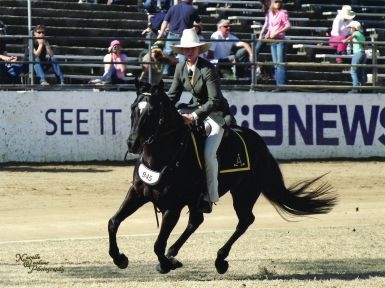 |
| Ilalong Talisman (photo: Narelle Wockner Photography) |
With the Australian Stock Horse Society's 40th Anniversary World Championship Show (9 - 15 May) fast approaching, we thought it was time to find out more about this wonderfully versatile, Australian made breed!
Pictured are Australian Stock Horse sires currently featured in Horsezone's Stallions at Stud Listings. (Click on the name below each photo to view more details).
Breed Characteristics and Standard of Excellence:
The Australian Stock Horse is often referred to as 'the breed for every need'. The Australian Stock Horse Society states, "The Australian Stock Horse is a fine working and performance animal, renowned for its toughness, endurance, resilience and strength. It also has cat-like speed and agility, giving the horse a cosmopolitan blend of attributes which have produced the world's best at work and play."
"The basic prerequisites of high performance sporting horses are a quiet temperament, intelligence and an athletic ability. The Australian Stock Horse has all of these qualities, and is now regarded as the benchmark for equestrian breeding excellence."
The following Standard of Excellence is based on the original ASHS description of 'The Australian Stock Horse' from 1971.
- Head alert and intelligent with broad forehead, full, well-set eyes, wide nostrils. A fine, clean gullet, allowing plenty of breathing room.
- A good length of rein, well set into the shoulder.
- Sloping shoulder, not too heavily muscled, a well-defined wither slightly higher than the croup.
- Deep chest, not too wide in proportion, but showing plenty of heart room.
- Ribs well sprung and back strong and of medium length in proportion.
- In forelegs, forearms well developed, cannon bones slightly flat, pasterns short and slightly sloping.
- Hindquarters strong, rounded and well muscled, nicely sloping to give a full line from croup to hock. Hocks broad, flat and clean, the cannon relatively short with well-defined tendons. The hind legs well under when standing.
- The Hooves hard and in proportion to the size of the horse, with a wide heel and feet straight.
- The whole of these component parts to be in balance according to the size.
- Preferred heights between 14 and 16 hands.
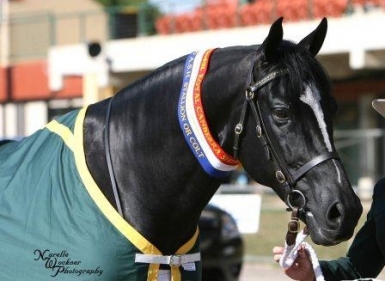 |
| Win D Fortitude (Photo: Narelle Wockner Photography) |
Talents:
Australian Stock Horses excel at many different horse sports. They are used for general riding and stock work on rural properties, as well as equestrian competitions. With its versatility, the Australian Stock Horse has achieved outstanding success in a wide variety of events including: campdrafting, showjumping, dressage, eventing, pony club events, harness, polo and polocrosse.
The main sport that is totally dominated by Australian Stock Horses is Campdrafting and this breed excels at it! This truly Australian sport, requires agility, intelligence and strength of both horse and rider. The horse must also have speed and 'cattle sense', which is required when the competitor selects a beast from the 'camp' or yard and separates it from the remaining cattle. After 'cutting-out' the beast, the rider has to work it with his horse around an outside course. Australian Stock Horses also excel in Polocrosse - another Australian sport - that requires fast, strong horses with stamina and a 'love of the game.' These horses must demonstrate intelligence, agility and control at speed.
Although traditionally used for these sports, Australian Stock Horses are also very popular for the more traditional equestrian disciplines including Dressage, Showjumping and Eventing, plus they are excellent pony club mounts, where a quiet temperament and ability to perform capably in a variety of events is prized.
History:
Development of the Australian Stock Horse as a breed has a long history, which goes back to the earliest days of Australian settlement. The Australian Stock Horse Society website provides very comprehensive information on the history of the breed:
The ancestors of the Australian Stock Horse arrived in Australia on the First Fleet in January 1788. The end of the 18th century saw horses imported into Botany Bay in small numbers, believed to be of Arabian and Barb blood. The Barb, developed on the Barbary Coast of North Africa, was a desert horse with great hardiness and stamina. Eventually more horses where imported, these were of English Thoroughbred and Spanish stock. Later importations included more Thoroughbreds, Arabs, Timor and Welsh Mountain Ponies. All horses sent to the Colony needed strength and stamina - not only to survive the long sea journey, but also to work in the foreign, untamed environment that had become their home.
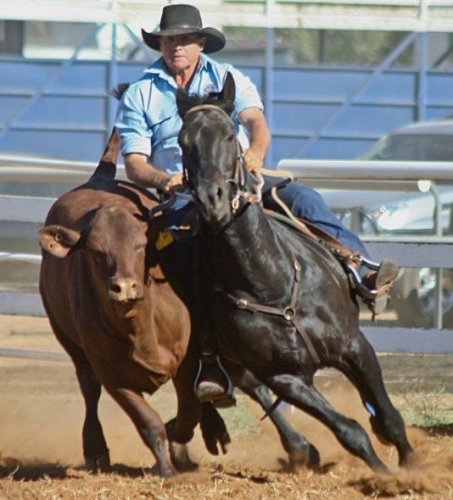 |
| Warrenbri Regal (Photo: TriColby Photography) |
In the 1830s, knowledgeable horse breeders imported a steady stream of Thoroughbreds to improve the local horse strains. The settlers had a keen interest in horse racing, so Thoroughbreds became very popular at the beginning of the 19th century. The use of Thoroughbred stallions over the condition-hardened local mares produced the beautiful strain of tough but stylish animal exemplified by today's Australian Stock Horse.
Explorers, stockmen, settlers, bushrangers and troopers all relied on horses that could travel long distances, day after day. Weak horses were culled; the stronger types were used to breed sturdy saddle horses that were essential for the Colony's settlement. Exploits of the explorers and stockmen and their reliable horses in the Australian bush became Australian folklore, and stories such as The Man from Snowy River and Clancy of the Overflow depict the character of these pioneers and their horses.
The Horse at War: Many Australians referred to their horses as stock horses or station horses. When purchased by a cavalry exporter, the horse became known as a remount horse. Originally all Australian horses came from New South Wales (thus the name Waler), but as the settlers spread throughout the continent, they took their horses with them. It was in 1846 that the term Waler was coined by the British. The hardiness of the Waler made him a natural mount for the cavalry. The Australian Army used the Waler in the First World War.
The origins of the Waler date back to 1840 and during the Boer War and World War I the Australian Horse received worldwide recognition through the success of the Australian Light Horse regiments, a quite significant achievement for horses in Australia's history. The Waler was considered to be the finest cavalry horse in the world, winning International acclaim for its endurance, reliability and hardiness during the Indian Mutiny, the Boer War and the First World War. In the Boer War, the Waler served in such regiments as the Lancers, Commonwealth Horse, Mounted Rifles and Bushmen's Troop.
Around 160,000 Australian horses served in World War I and their performance was best summed up by the English cavalryman, Lt Col RMP Preston DSO, in his book, 'The Desert Mounted Corps'. He described the stamina and spirit of the Australian Light Horse, "… Cavalry Division had covered nearly 170 miles…and their horses had been watered on an average of once in every 36 hours…. The heat, too, had been intense and the short rations, 9½ lb of grain per day without bulk food, had weakened them considerably. Indeed, the hardship endured by some horses was almost incredible. One of the batteries of the Australian Mounted Division had only been able to water its horses three times in the last nine days - the actual intervals being 68, 72 and 76 hours respectively, yet this battery on its arrival had lost only eight horses from exhaustion…. The majority of horses in the Corps were Walers and there is no doubt that these hardy Australian horses make the finest cavalry mounts in the world.
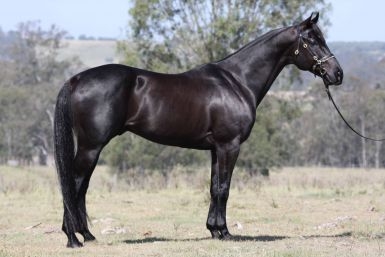 |
| Binnia Gunslinger |
Although many good breeding stock left Australia never to return, the huge shipments did not seem to affect the horse population at home. In 1906 Australia had 1,765,186 horses and in 1918 when the human census was 5,030,479 there were 2,527,149 horses. As a result, a small group of horsemen deemed it important to establish the Society so that these great horses would not be lost genetically and future generations could be recognised and officially recorded.
After the First World War, despite the recognition Australian Horses had won and although the Waler was known as a distinctive type, there was no Stud Book or Registry. Mechanisation of primary industries reduced the need for working horses and it was not until the 1960s that an interest in horses was revived due to the increasing leisure time available to society."
In June 1971, the Australian Horse was given the recognition and formal organisation it deserved with The Australian Stock Horse Society being established. The procedure to register horses was established.
In 1996, the Society's Silver Jubilee year, 130,000 horses had been registered or recorded with the Society. Since the closure of the Society's Stud Book, only horses that comply with the Society's regulations have been accepted for registration. In the last decade the Society has experienced unprecedented growth as the demand for Australian Stock Horses and recognition of their many attributes has increased. In the last ten years the Membership of the Society has doubled to over 9,500 and in excess of 170,000 horses have been registered or recorded in the Stud Book.
CLICK HERE to visit the Australian Stock Horse Society website and find out more about the studbook, classification process and read further details on the Society.
40th Anniversary Australian Stock Horse Society World Championship Show
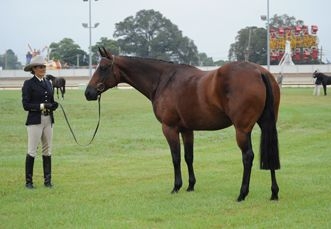 |
| Braeview Jillian is currently FOR SALE on Horsezone |
The 40th Anniversary Australian Stock Horse Society World Championship Show, an official celebration of the Society's 40 year anniversary, will be held from 9 - 15 May 2011 and will include the 2011 Fountain of Youth National Yearling and Two Year Old Sale on the 11 May 2011, these two events will both be held at the AELEC, Tamworth NSW.
The full show programme will include National Futurity, National Maturity, Maiden Campdraft Series, ABBEY Open Challenge, Youth Challenge, ASHLA as well as classes ranging from led and hacking to working, sporting and dressage.
CLICK HERE for more details on the 40th Anniversary Show, including the full programme, judges and campdraft draws.
To view Australian Stock Horses currently listed for sale on Horsezone CLICK HERE or HERE to sell horses. To view more of the Australian Stock Horse stallion services listed on Horsezone CLICK HERE.
Information Source: www.ashs.com.au
News Search
Categories
- General
- Event Results
- Stallionzone
- Sponsored Shows
- Clubs
- Health
- Feature Horses
- Competitions
- Five Minutes With Horsezone
- Young Riders
- Reviews
- Training and Clinics
- Postcards from the saddle
- 2014 Equitana by HORSE FIRST
- 2013 Equitana
- 2012 Equitana
- 2012 London
- 2011 Equitana
- 2011 Queensland Floods
- 2010 WEG
